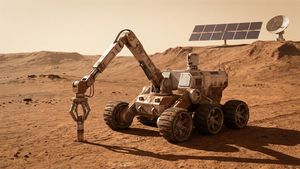HIGHLIGHTS
- Atlas Lithium has more than doubled its lithium exploration portfolio in Brazil to approximately 539 km² (approximately 133,294 acres). Most of the new claims are in the promising Doce River and Mucuri Valleys, an exciting new lithium jurisdiction in Brazil that has been relatively underexplored for lithium.
- Atlas Lithium's dense media separation plant to produce lithium concentrate has finished trial assembly and is being prepared for shipment to site in Q3 2024, with the goal of commissioning and commencing production at the flagship Neves Project in Q4 2024.
- The Company is progressing on a Definitive Feasibility Study (DFS) for the Neves Project, which is expected to be completed and released prior to commencing initial production. The DFS will incorporate an updated Mineral Resource Estimate (MRE) encompassing the Anitta 1, Anitta 2, and Anitta 3 deposits.
Boca Raton, Florida--(Newsfile Corp. - June 17, 2024) - Atlas Lithium Corporation (NASDAQ: ATLX) ("Atlas Lithium" or "Company"), a leading lithium exploration and development company, is excited to announce significant progress towards production of lithium concentrate in Q4 2024 as well as a substantial expansion of its lithium mineral rights footprint in Brazil. The Company is moving rapidly towards commencing production at its flagship Neves project in Q4, 2024. In addition, Atlas Lithium has more than doubled its lithium exploration portfolio in Brazil to approximately 539 km² with the addition of multiple promising mineral rights in the Doce River and Mucuri Valleys, new frontiers for lithium in Brazil. The Company's initial exploration campaign within these new districts is located near Governador Valadares, a city with approximately 280,000 inhabitants and an important regional center in the state of Minas Gerais, with favorable infrastructure and access roads, and ~ 350 km (~ 217 miles) from the Port of Vitoria, making it highly attractive for lithium exploration and development. Atlas Lithium believes that it has the largest claim ownership position of any listed company in this new lithium frontier providing the Company with a highly strategic first-mover advantage.
With these additions, Atlas Lithium believes that it has the largest lithium exploration footprint in Brazil now totaling 53,942 hectares (approximately 539 km2 or 133,294 acres). To put it into perspective, such an area is greater than 9 times that of Manhattan Island in New York.
"Our new mineral rights near Governador Valadares provide access to an exciting new lithium frontier in Brazil that has been relatively untapped beyond gemstone mining," commented James Abson, Chief Geology Officer at the Company. "This region of Minas Gerais state hosts dozens of documented lithium-rich pegmatites, presenting an opportunity for us."
Nick Rowley, Vice President of Business Development at Atlas Lithium, added, "Pushing towards becoming a producer of lithium concentrate is our top focus in the short term. We have been also working on significantly increasing our overall mineral rights holdings to solidify our leading position in Brazil, which is attracting increasing interest globally as a hub for hard-rock lithium production."
Valadares Project
Current exploration campaign at the Valadares Project is focused on initial areas situated approximately 50 km from the city of Governor Valadares City, being strategically located within the renowned Eastern Brazilian Pegmatite Province (EBPP), one of the largest pegmatite provinces in the world.
The EBPP is home to some world-class, economically significant lithium-bearing LCT pegmatites. The newly acquired Atlas Lithium permits lie within the highly prospective Joao Pinto schist units, which have been intruded by the Galiléia tonalites and other granitic bodies, including numerous LCT ("lithium-cesium-tantalum") pegmatites.
According to the CPRM (the Brazilian Geological Survey), four lithium mineralized pegmatite occurrences have been identified within the Company's permits, two of which have been confirmed to contain spodumene. Other reported lithium minerals include lepidolite and amblygonite, along with accessory minerals such as colombo-tantalite. During initial reconnaissance mapping and sampling, the Company's exploration team discovered an additional six spodumene-bearing pegmatites, further highlighting the potential of these new claims.
One particularly promising spodumene-bearing pegmatite, estimated to be at least 20m wide and flat-lying, has been extensively mined by artisanal miners for tourmalines using underground galleries (Figure 1). First-pass samples of spodumene crystals, taken from within these galleries, returned Li₂O grades greater than 3.23% Li₂O, which is the upper limit of such assay method. Subsequently, the galleries were laser scanned in 3D to provide a map of the pegmatite dimensions (Figure 2), aiding in the planning of the future scout drill collar locations. Currently, a detailed map is being compiled, highlighting the positions of spodumene crystals and spodumene-enriched zones that will further guide an upcoming drilling campaign.
Figure 1: Atlas Lithium exploration geologist inside the prior underground artisanal mining gallery at the Valadares Project
To view an enhanced version of this graphic, please visit:
https://images.newsfilecorp.com/files/6706/213213_79a34f2154ff5a8e_003full.jpg
Figure 2: LiDAR DTM topography map (terrestrial laser scan) showing prior artisanal mining pegmatite galleries in relation to 1st-pass spodumene sampling results as well as detailed spodumene mapping points.
To view an enhanced version of this graphic, please visit:
https://images.newsfilecorp.com/files/6706/213213_79a34f2154ff5a8e_004full.jpg
Within these galleries, numerous zones of large spodumene crystals, some exceeding 20cm in width and 70cm in length, were discovered by the Company's geologists (Figures 3, 4, 5). The presence of lithium has been confirmed by UV fluorescence and by the SciAps LIBS Analyzer.
Figure 3: Spodumene zone visible within the prior artisanal mining gallery at the Valadares Project.
To view an enhanced version of this graphic, please visit:
https://images.newsfilecorp.com/files/6706/213213_79a34f2154ff5a8e_005full.jpg
Figure 4: Spodumene zone visible within the prior artisanal mining gallery at the Valadares Project.
To view an enhanced version of this graphic, please visit:
https://images.newsfilecorp.com/files/6706/213213_79a34f2154ff5a8e_006full.jpg
Figure 5: Spodumene zone (in pink) within the prior artisanal mining gallery at the Valadares Project under UV light fluorescence.
To view an enhanced version of this graphic, please visit:
https://images.newsfilecorp.com/files/6706/213213_79a34f2154ff5a8e_007full.jpg
High-resolution drone Orthomosaic imagery and LiDAR topography data has been acquired and is being analyzed. Additionally, drone magnetics and radiometric geophysics surveys have been commissioned to assist with drill targeting.
Coronel Murta Project
The Company's Coronel Murta Project is situated approximately 50 km northwest of the Neves Project and contains numerous pegmatite swarms of the Eastern Brazilian Pegmatite Province (EBP). The current priority target area is in the general area where at least two spodumene-bearing pegmatite occurrences have been reported by CPRM, the Brazilian Geological Service. One of these, the Barro do Salinas pegmatite, lies within the Company's tenement.
Atlas Lithium has commissioned a study to identify potential pegmatite targets (outcrop and workings) using Sentinel-2 multi-band spectral imagery and other high-resolution satellite imagery. The study identified several north-west to south-east trending targets, which align with the trends of the known spodumene-bearing pegmatites in the area. The Company's exploration team has completed the initial geological mapping of this permit and has started a detailed soil sampling campaign designed to highlight any lithium or LCT-pegmatite pathfinder element trends cutting across the permit. Preliminary XRF element analysis has already identified anomalous concentrations of cesium in certain of these soil samples, indicating the likely presence of other LCT pegmatites on the property.
Furthermore, Atlas Lithium has commissioned a comprehensive suite of high-resolution drone surveys over the permit area, including LiDAR, RGB, and multi-spectral imaging. These surveys will provide valuable data to support detailed mapping efforts and aid in the identification and delineation of pegmatite bodies. Upon completion of such studies, the Company will conduct a high-resolution drone magnetics geophysics survey utilizing its in-house equipment. Building on the insights gained from these initial exploration activities, Atlas Lithium intends to expand its scout drilling campaign to this high-priority area.
Neves Project
The Company's geological team continues to actively drill within the Neves Project area. Previously discovered mineralized pegmatites in the Neves Project were initially located with the help of historic artisanal mines, outcroppings of pegmatite, or shallow sub-crop unearthed by trenching Li in soil anomalies. To date, Atlas Lithium has mapped and sampled over 84 pegmatite outcrops within the Neves. In an effort to expedite the exploration of the sizeable Neves claims, in late 2023, the Company embarked on a systematic exploration campaign designed by James Abson, the Atlas Lithium's Chief Geology Officer.
The Project area has now been covered by:
Detailed hyperspectral satellite and drone LiDAR mapping to aid in faster pegmatite discovery;
Geological mapping and rock sampling to improve target prioritization;
Closely spaced soil sampling grids, with 4,599 samples taken to date, to highlight Li (>100ppm threshold) and LCT pegmatite pathfinder anomalies for drill testing;
High-resolution drone geophysics surveys, including magnetics and radiometrics, to assist with mapping and drill targeting.
The comprehensive data sets have generated several highly promising coincident and parallel targets (Figure 6). One notable example is a linear lithium anomaly with a strike length of 1.2 km, which coincides with the Anitta 2 mineralized pegmatite. While some of these targets may represent extensions of the known mineralized Anitta trends, others could potentially indicate entirely new, untested pegmatite discoveries, particularly in the southern region of Neves.
The practical application of this new lithium soil anomaly information is exemplified at Anitta 1. Previously, an unexplained anomaly existed to the east of the drilled orebody. Guided by this anomaly, recent additional drilling has now uncovered the up-dip extension of Anitta 1 and a parallel orebody immediately to the east. These discoveries are expected to contribute to the project's overall mineralized pegmatite tonnage, demonstrating the effectiveness of the exploration approach in identifying and delineating high-quality lithium mineralization.
Figure 6: Soil sampling lithium anomaly map in relation to mapped pegmatites (in pink), the mineralized Anitta pegmatites, topography, and structural geophysics data.
To view an enhanced version of this graphic, please visit:
https://images.newsfilecorp.com/files/6706/213213_79a34f2154ff5a8e_008full.jpg
It is important to recognize that drilled lithium-mineralized sections of pegmatites can extend up to 150m along strike beyond the termination of the surface lithium anomaly, as observed in the case of Anitta 2. In certain areas, it is probable that these pegmatites continue undetected from the surface along the same strike direction, particularly beneath higher hills where the cover and weathering profiles may be thicker. The Company's exploration team is currently evaluating the potential use of other less mobile LCT markers, such as Cs, Sn, and Ta, to identify new anomalous trends or extensions that warrant further investigation.
Furthermore, the majority of the Anitta pegmatites exhibit a close association with magnetic lows and NNE-SSW structural lineaments. This valuable information will enable the Atlas Lithium team to refine its approach to future exploration targeting activities. These studies will include more detailed follow-up work, such as infill soil grids, trenching, and drilling, to better delineate and characterize the identified targets.
James Abson, Chief Geology Officer at Atlas Lithium, commented, "Armed with this large and significant new set of systematic exploration data, varying from anomalous soil geochemistry to geophysical anomalies to geophysical structures and signatures structures related to known mineralized pegmatites, we are advancing our knowledge of the Neves Project. In fact, Atlas Lithium's exploration team has begun a scout drilling program to drill out the newly identified targets using the quicker and more cost-effective RC drilling method to test any new high-interest coincident anomalies previously untested."
"In parallel with the geological efforts, and to better align this work with the Company's objective of production in Q4 2024, the decision has been made to upgrade the PEA to a Definitive Feasibility Study, and to release it prior to production," stated Brian Talbot, Chief Operating Officer and director at Atlas Lithium. "Our goal remains to transform Atlas Lithium into a low-cost lithium producer in Brazil, leveraging our extensive tenement portfolio to develop multiple projects across the country."
About Atlas Lithium Corporation
Atlas Lithium Corporation (NASDAQ: ATLX) is focused on advancing and developing its 100%-owned hard-rock lithium project in Brazil's Lithium Valley, a well-known lithium district in the state of Minas Gerais. In addition, Atlas Lithium has 100% ownership of mineral rights for other battery and critical metals including nickel, rare earths, titanium, graphite, and copper. The Company also owns equity stakes in Apollo Resources Corp. (private company; iron) and Jupiter Gold Corp. (OTCQB: JUPGF) (gold and quartzite).
Safe Harbor Statement
This press release contains forward-looking statements within the meaning of Section 27A of the Securities Act of 1933 and Section 21E of the Securities Exchange Act of 1934. Forward looking statements are based upon the current plans, estimates and projections of Atlas Lithium and its subsidiaries and are subject to inherent risks and uncertainties which could cause actual results to differ from the forward- looking statements. Such statements include, among others, those concerning market and industry segment growth and demand and acceptance of new and existing products; any projections of production, reserves, sales, earnings, revenue, margins or other financial items; any statements of the plans, strategies and objectives of management for future operations; any statements regarding future economic conditions or performance; uncertainties related to conducting business in Brazil, as well as all assumptions, expectations, predictions, intentions or beliefs about future events. Therefore, you should not place undue reliance on these forward-looking statements. The following factors, among others, could cause actual results to differ from those set forth in the forward-looking statements: results from ongoing geotechnical analysis of projects; business conditions in Brazil; general economic conditions, geopolitical events, and regulatory changes; availability of capital; Atlas Lithium's ability to maintain its competitive position; manipulative attempts by short sellers to drive down our stock price; and dependence on key management.
Additional risks related to the Company and its subsidiaries are more fully discussed in the section entitled "Risk Factors" in the Company's Form 10-K filed with the Securities and Exchange Commission (the "SEC") on March 27, 2024. Please also refer to the Company's other filings with the SEC, all of which are available at www.sec.gov. In addition, any forward-looking statements represent the Company's views only as of today and should not be relied upon as representing its views as of any subsequent date. The Company explicitly disclaims any obligation to update any forward-looking statements.
Investor Relations:
Brian Bernier
Vice President, Investor Relations
+1 (833) 661-7900
bwb@atlas-lithium.com
https://www.atlas-lithium.com/
@Atlas_Lithium

To view the source version of this press release, please visit https://www.newsfilecorp.com/release/213213











